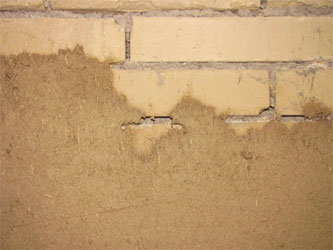Clay as material in civil engineering
 Clay is the construction material used almost all around the year for ages.
Clay is the construction material used almost all around the year for ages.
As a construction material, it was considered to be obsolete and outdated in our country in recent past. It was uselessly replaced with "modern" materials where its extraordinary properties were absent.
Nowadays, raw clay may become a valuable alternative of conventional materials.
Clay materials can find their place in particular in environment-friendly and low-energy building.
Clay plasters
Clay plasters are excellent for combination with other natural materials, such as reed, stone, wood, etc. Materials are not aggressive, they meet the environmental and health criteria.
When mixed, mucous membrane is not irritated, they do not stink, on contrary, they smell nice - in particular those ones comprising herbs. In the case of an accidental spraying of window glass sheets or wooden structures they do not stain on contrary to lime and cement plasters and they are easy to clean.
Coarse clay plasters, similarly as lime and cement ones, serve for the levelling of foundation. They are usually applied in 15-25 mm thickness onto any foundations.
For absorbent foundations, such as kiln brick and raw brick, plaster is to be applied directly onto the foundation treated with penetration paint beforehand.
For non-absorbent or smooth surfaces (smooth concrete), it shall be necessary to create a coarse surface using cement spray.
For wooden surfaces (board flap, OSBs), reed mat should be mechanically attached or a wooden grid should be made of 20x20 mm laths, onto which the plaster should be fixed.
Plasters may be applied manually or using machines. Clay plasters with an admixture of straw or hemp fibres are the best for the application of thicker layers (20-30 mm). These plasters are suitable also for application onto problematic foundations (mixed masonry, wooden foundation), where it comes to the restriction of crack formation thanks to the presence of organic fibres.
Fine plasters are applied to the coarse plasters after they are perfectly dry. Fine plasters are mostly made of clay and sand with 1-2 mm grain. Some fine plasters comprise also fibres preventing cracking.
They are applied in one or two layers at the thickness of 2 to 6 mm. It is possible to incorporate reinforcing grate to the first layer.
Surface of fine plasters is felted in majority of cases. Such created surface need not to be further treated or it may be painted with casein or lime paints.
Such types of paints are highly permeable for vapour and do not restrict the humidity regulating ability of plasters.
Clay bricks and panels
 Clay bricks proved their properties very well in particular in wood-framed buildings and houses with forced air exchange, where they significantly contribute to the stabilisation of the internal environment, both from thermal and humidity point of view.
Clay bricks proved their properties very well in particular in wood-framed buildings and houses with forced air exchange, where they significantly contribute to the stabilisation of the internal environment, both from thermal and humidity point of view.
They are used mainly for the construction of non-carrying interior partition walls. They are to be worked with the same way as when laying kiln bricks, yet with the difference you can build maximum seven rows - ca 1 m wall height within a day.
It is caused by a slow drying out of masonry clay mortar that could be the cause of wall deformation or falling down due to the high load. After drying and thus hardening of mortar it is possible to continue with bricklaying without any problems.
Such brick-laid partition wall is to be subsequently plastered with coarse and fine clay plaster with the thickness of 15-20 mm.
Clay panels belong to the new construction materials. They are usually produced with the minimum percentage of sand and therefore they very well regulate humidity in interior.
They are produced in 20 to 50 mm thickness. The panels are to be mounted directly onto a wooden screen or flap, wooden or made of OSB. It is possible to coat ceilings, oblique false ceilings, curtain walls or to form partition walls as well.
A thin layer of clay plaster with reinforcing grid should be applied onto such created surface and the plaster could be painted the next day.
This material is mainly suitable for wood-framed buildings and everywhere a speed of work is required.
Clay plaster advantages
- breathability
- ability to accumulate heat
- ability to create the feeling of a thermal comfort
- excellent sound-proof properties
- humidity regulation
- 100% recyclability
- easy accessibility of input raw material
The use of clay in civil engineering
- carrying walls made of clay bricks
- clay plasters, coarse and fine
- filler material, partition walls
- clay floors
- non-carrying accumulation walls
- binding agent - clay mortar
- the construction of various types of kilns and furnaces
 Clay is the construction material used almost all around the year for ages.
Clay is the construction material used almost all around the year for ages. Clay bricks proved their properties very well in particular in wood-framed buildings and houses with forced air exchange, where they significantly contribute to the stabilisation of the internal environment, both from thermal and humidity point of view.
Clay bricks proved their properties very well in particular in wood-framed buildings and houses with forced air exchange, where they significantly contribute to the stabilisation of the internal environment, both from thermal and humidity point of view.